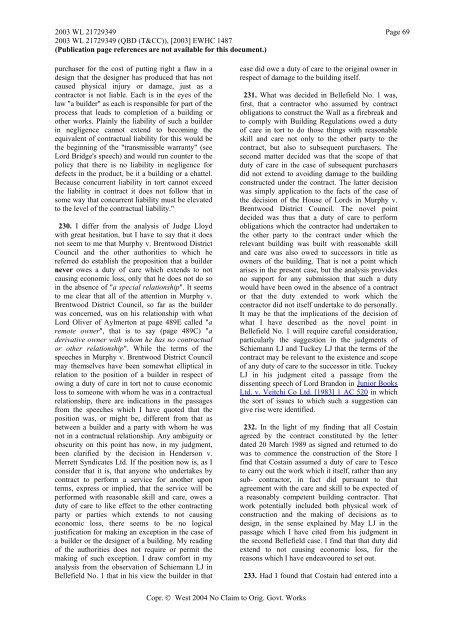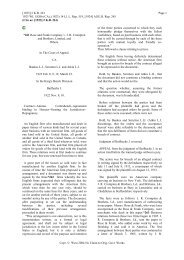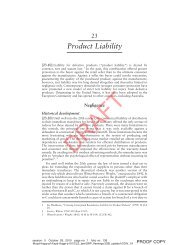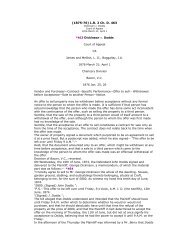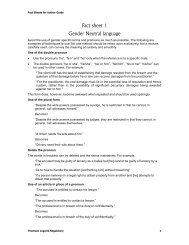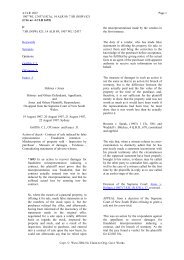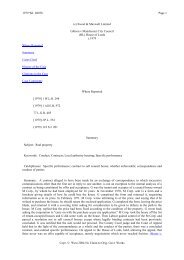Tesco v Constain - Thomson Reuters
Tesco v Constain - Thomson Reuters
Tesco v Constain - Thomson Reuters
You also want an ePaper? Increase the reach of your titles
YUMPU automatically turns print PDFs into web optimized ePapers that Google loves.
2003 WL 21729349 Page 692003 WL 21729349 (QBD (T&CC)), [2003] EWHC 1487(Publication page references are not available for this document.)purchaser for the cost of putting right a flaw in adesign that the designer has produced that has notcaused physical injury or damage, just as acontractor is not liable. Each is in the eyes of thelaw "a builder" as each is responsible for part of theprocess that leads to completion of a building orother works. Plainly the liability of such a builderin negligence cannot extend to becoming theequivalent of contractual liability for this would bethe beginning of the "transmissible warranty" (seeLord Bridge's speech) and would run counter to thepolicy that there is no liability in negligence fordefects in the product, be it a building or a chattel.Because concurrent liability in tort cannot exceedthe liability in contract it does not follow that insome way that concurrent liability must be elevatedto the level of the contractual liability."230. I differ from the analysis of Judge Lloydwith great hesitation, but I have to say that it doesnot seem to me that Murphy v. Brentwood DistrictCouncil and the other authorities to which hereferred do establish the proposition that a buildernever owes a duty of care which extends to notcausing economic loss, only that he does not do soin the absence of "a special relationship". It seemsto me clear that all of the attention in Murphy v.Brentwood District Council, so far as the builderwas concerned, was on his relationship with whatLord Oliver of Aylmerton at page 489E called "aremote owner", that is to say (page 489C) "aderivative owner with whom he has no contractualor other relationship". While the terms of thespeeches in Murphy v. Brentwood District Councilmay themselves have been somewhat elliptical inrelation to the position of a builder in respect ofowing a duty of care in tort not to cause economicloss to someone with whom he was in a contractualrelationship, there are indications in the passagesfrom the speeches which I have quoted that theposition was, or might be, different from that asbetween a builder and a party with whom he wasnot in a contractual relationship. Any ambiguity orobscurity on this point has now, in my judgment,been clarified by the decision in Henderson v.Merrett Syndicates Ltd. If the position now is, as Iconsider that it is, that anyone who undertakes bycontract to perform a service for another uponterms, express or implied, that the service will beperformed with reasonable skill and care, owes aduty of care to like effect to the other contractingparty or parties which extends to not causingeconomic loss, there seems to be no logicaljustification for making an exception in the case ofa builder or the designer of a building. My readingof the authorities does not require or permit themaking of such exception. I draw comfort in myanalysis from the observation of Schiemann LJ inBellefield No. 1 that in his view the builder in thatcase did owe a duty of care to the original owner inrespect of damage to the building itself.231. What was decided in Bellefield No. 1 was,first, that a contractor who assumed by contractobligations to construct the Wall as a firebreak andto comply with Building Regulations owed a dutyof care in tort to do those things with reasonableskill and care not only to the other party to thecontract, but also to subsequent purchasers. Thesecond matter decided was that the scope of thatduty of care in the case of subsequent purchasersdid not extend to avoiding damage to the buildingconstructed under the contract. The latter decisionwas simply application to the facts of the case ofthe decision of the House of Lords in Murphy v.Brentwood District Council. The novel pointdecided was thus that a duty of care to performobligations which the contractor had undertaken tothe other party to the contract under which therelevant building was built with reasonable skilland care was also owed to successors in title asowners of the building. That is not a point whicharises in the present case, but the analysis providesno support for any submission that such a dutywould have been owed in the absence of a contractor that the duty extended to work which thecontractor did not itself undertake to do personally.It may be that the implications of the decision ofwhat I have described as the novel point inBellefield No. 1 will require careful consideration,particularly the suggestion in the judgments ofSchiemann LJ and Tuckey LJ that the terms of thecontract may be relevant to the existence and scopeof any duty of care to the successor in title. TuckeyLJ in his judgment cited a passage from thedissenting speech of Lord Brandon in HJunior BooksLtd. v. Veitchi Co Ltd. [1983] 1 AC 520 in whichthe sort of issues to which such a suggestion cangive rise were identified.232. In the light of my finding that all Costainagreed by the contract constituted by the letterdated 20 March 1989 as signed and returned to dowas to commence the construction of the Store Ifind that Costain assumed a duty of care to <strong>Tesco</strong>to carry out the work which it itself, rather than anysub- contractor, in fact did pursuant to thatagreement with the care and skill to be expected ofa reasonably competent building contractor. Thatwork potentially included both physical work ofconstruction and the making of decisions as todesign, in the sense explained by May LJ in thepassage which I have cited from his judgment inthe second Bellefield case. I find that that duty didextend to not causing economic loss, for thereasons which I have endeavoured to set out.233. Had I found that Costain had entered into aCopr. © West 2004 No Claim to Orig. Govt. Works


